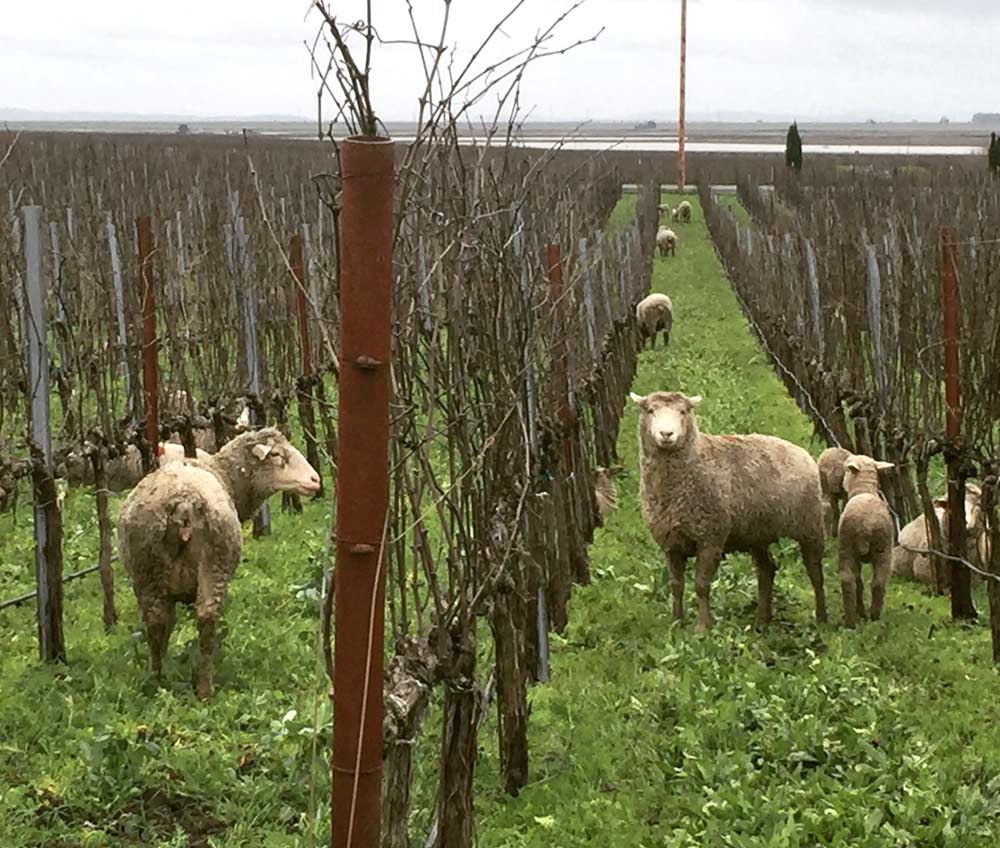
Sheep don’t care if weeds have developed herbicide resistance, so they are increasing popular in California vineyards, like these ewes and lambs seen in January, 2017 in Robert Sinskey Vineyards in Napa, California. (Courtesy Debby Zygielbaum)
With growing problems from herbicide resistant weeds in California vineyards, some growers are turning to a truly traditional weed control practice: grazing.
“We have a lot of commercial vineyards that are using sheep to go through and clean off a lot of weeds,” said John Roncoroni, a weed specialist with the University of California extension in Napa County. “The people who are really using sheep are using 200 per acre, running them with electric fences so they’ll eat the weeds down and keep them moving.”
Sheep will happily eat herbicide resistant weeds and large weed skeletons, but they’ll also happily munch on grapevines. The key is to move them through the vineyards before bud break, or use them post-harvest.
“I can tell you anecdotally that it invigorates the blocks; they are spreading manure everywhere,” said Debby Zygielbaum, a Napa-area vineyard consultant who weeded with sheep every spring for about a decade as a vineyard manager at Robert Sinskey Vineyards. It’s not without headaches, a sheep can rub against trellises or knock off drip emitters, and you need some place to pasture them if buds break earlier than expected, she said, but overall “it’s a great farming practice if you can work it out.”
If the logistical challenges of setting sheep free in your vineyards doesn’t appeal to you, there are other non-herbicidal weed control options available. Using some of these strategies to practice integrated weed control that reduces reliance on herbicides is increasingly important, Roncoroni said, now that it’s apparent over-reliance on glyphosate is taking a toll on the product’s effectiveness.
“For a long time, we were stuck in a post-emergent only weed control world, using RoundUp because people were looking at not changing the soil,” he said. “But biologically, we use way too much, that’s why we have resistance.”
He advocates reintroducing occasional cultivation when possible, especially because many of the current problem weeds in California vineyards, like herbicide-resistant horseweed and ryegrass, are commonly found in undisturbed roadsides, not cultivated fields.
“We used glyphosate to kill all the easy ones,” Roncoroni said, but the remaining challenges are very drought tolerant and compete for scarce water resources with the vines.
Cultivation costs do add up, considering that every acre of grapes is a mile of vine row but even adding it in every few years would help by reducing both weeds and the herbicide pressure that’s driving resistance, Roncoroni said. “Unfortunately, grapes like to grow in rocky, hilly areas where it’s hard to use cultivation,” he added.
Besides sheep and tilling, other options for diversifying weed control include using mulch or cover crops, flaming and using pre-emergent herbicides. Each option has its downsides, from mulch or cover crops attracting voles to flamers that can start fires if grass is too tall or too dry.
To get the best performance out of pre-emergent herbicides, Roncoroni recommends sweeping the vineyard first to remove residual weed skeletons or grape leaves that prevent the herbicide from getting good soil coverage.
“You can really see a difference,” he said. “There’s nothing worse than a wasted pass, wasting herbicide, wasting gas, wasting time.”
The benefits of sweeping plus pre-emergents can even carry over into the next year, reducing weeds that trap fallen grape leaves. Without the weeds, the leaves blow away during the winter and growers have a clean floor for the next season and that “nice clean slate to start with takes less management,” Roncoroni said.
That’s the sort of added benefit he urges growers to take advantage of, but he acknowledges that weed control is typically last in vineyard budgets. “Every year, we do 80 percent of the weed control we need,” he said in a presentation to growers last December. But shifting more of that budget to extra weed control one year — cultivation, pre-emergents or more mowing — could reduce management needs and costs the following years.
Or sheep. Although right now, there may be more demand for sheep in the Napa Valley than availability, Zygielbaum said. Growers no longer get paid for providing the sheep with forage, as they did decades ago, instead they pay for transporting the animals and rent them by acre or by ewe, but for many, it’s worth the investment.
On 200 acres at Robert Sinskey Vineyards, grazing for two months was “basically the cost of a couple of mowing passes,” she said. And unlike tractors, which tend to get stuck in the mud in early spring, sheep can handle the conditions. •
—by Kate Prengaman
Sheep tips
—Find a shepherd to work with, who can take care of the sheep day to day, unless you want to be a full-time sheep farmer as well as a grape grower.
—Try to match herd size to vineyard size and timing needs; good coverage gets good weed control, but hungry sheep need regular rotation to fresh pasture.
—Many sheep breeds will work. You don’t need boutique babydoll sheep, but larger breeds may cause more damage if they lean on trellis or rub on irrigation mains.
—In most vineyards, sheep just graze before bud break, but some growers are designing vineyards with tall trellis and high-wire training systems to accommodate sheep all year-round.
Source: Debby Zygielbaum






Leave A Comment